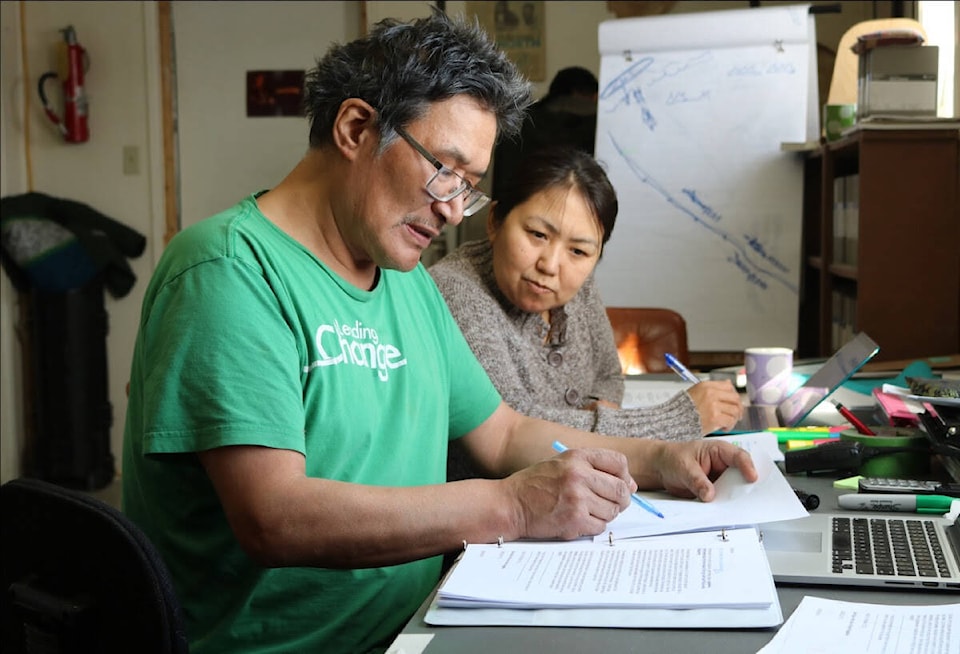As a little girl in the early ’80s, Lucy Tulugarjuk said she would spend most of her time playing outside instead of in front of a screen.
Her family and friends in Iglulik did not own televisions, she said, with most households choosing to keep television out as a way to protect Inuit culture.
But she recalled that when she was five years old, she heard people in the nearby community of Hall Beach were watching TV, and the medium piqued her interest.
“It was interesting to see what TV had to bring. And we heard that it was just in English and French, no Inuktitut,” Tulugarjuk said.
“At the time, I didn’t understand why.”
Now, Tulugarjuk is the executive director of an independent broadcaster whose mission is to bring Inuit language and culture to the small screen not just in Nunavut, but across the country.
Preserving Inuit storytelling has become fundamental, she said, since she described witnessing an erosion of culture when local kids watched TV in English and French: “It did impact our children.”
In 2021, Tulugarjuk’s Nunavut Independent Television Network launched Uvagut TV, meaning “our TV,” becoming Canada’s first national Indigenous-language television channel.
It delivers 90 per cent of its 24/7 broadcast in Inuktitut, including national and regional news and children’s programming.
And it is dreaming even bigger. The network is applying to the federal broadcast regulator, the Canadian Radio-television and Telecommunications Commission, to be a mandatory part of the coverage in basic TV packages.
If their application is approved at a hearing, which is expected sometime this year, it would require broadcasters across Canada to carry Uvagut TV.
“It would be such a gift for all Canadians to have access, and to be able to see and learn about Inuit with Inuit,” said Qajaq Robinson, who is the secretary treasurer of the NITV’s board of directors and also served as one of the commissioners of the National Inquiry into Missing and Murdered Indigenous Women and Girls.
“To have access to the language and content that reflects them and speaks to them — that supports the promotion and protection of life.”
Robinson pointed to Inuit broadcaster Rosemarie Kuptana’s 1982 “neutron bomb” speech at a CRTC hearing.
Kuptana described the arrival of southern mainstream media in Inuit communities as “the bomb that kills the people, but leaves the buildings standings” because of the impact the media had on languages.
She said it was “the kind of television that destroys the soul of a people but leaves the shell of a people walking around.”
One year after her speech, the federal Liberal government established a northern broadcasting policy.
Television can be an important medium to reintroduce Indigenous languages to people, just as it introduced mainstream English and French to those in the north in the ’80s, Robinson said.
“The dream of Canada has to have authentic space for Indigenous people, Inuit specifically,” she said.
“Indigenous people aren’t a monolith. They’re not all the same.”
Step toward reconciliation
While Uvagut TV offers almost all of its content in Inuktitut, CBC TV’s offering of Indigenous-language programming amounted to about 367 hours from April 2021 to March 2022, according to the national broadcaster.
About 227 of those hours were in Inuktitut, CBC said, which works out to about nine-and-a-half days’ worth of content.
Should Uvagut TV be granted mandatory inclusion in basic TV packages, it’d be a step toward reconciliation, said Robinson.
The company has until Feb. 9 to submit an application, and it says it believes its pitch is in line with the federal government’s mandate, though the CRTC is an arm’s-length body.
In 2019, Parliament passed the Indigenous Languages Act, which states in its preamble that it aims to implement the United Nations Declaration of the Rights of Indigenous Peoples. The document affirms that Indigenous Peoples have the right to establish their own media in their own languages.
While Uvagut TV broadcasts mainly in Inuktitut, English subtitles are available for many of its programs, making it accessible to a broader audience.
The network’s 610,000 subscribers currently watch through Shaw Direct satellite TV, Arctic Co-operatives Limited cable in Nunavut and the Northwest Territories and Federation des Cooperatives du Nouveau-Quebec cable in Nunavik.
“Broadcasting is natural storytelling,” Tulugarjuk said, adding that Inuit communication is “more verbal than written” and oral stories are how the community shares its past and its dreams for the future.
“So it’s a way of using our voice and expressions to (reach out to) the world. Not just to Inuit, but to everyone.”
— Mickey Djuric, Canadian Press
